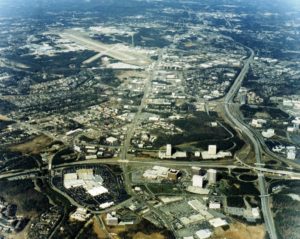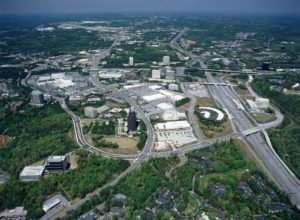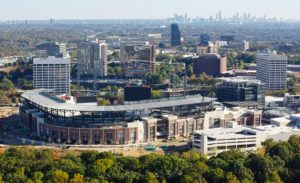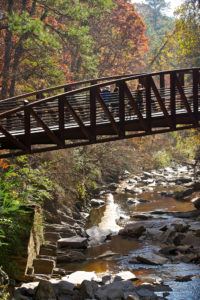Some people may not think that re-engineering a road qualifies as “revitalization,” but I do.
To be clear, I get just as emotional as the next person when I see a church saved from the wrecking ball or a neighborhood park brought back to life through children’s laughter. But those examples of revitalization usually take place in communities that are showing their age after 50, 75, or even 100 years. What if your community hasn’t yet reached that age but still needs thoughtful attention?

Not only a commercial submarket heavyweight, the Cumberland CID offers access to thousands of acres of unspoiled national parkland.
I run an organization that sees revitalization through a different lens. The lens of protecting commercial property assets; specifically $5.4 billion worth of property investments (with $3.3 billion being the commercial ownership.) Those of you in commercial real estate understand very clearly that the land use and development patterns of the ‘70s and ‘80s are, shall we say, not ‘en vogue’ these days and your bottom line is either being helped or hurt by that fact.
This brings me to my community. Cumberland is a submarket in Atlanta, Georgia. It’s about 10 miles northwest of downtown and encompasses the intersection of Interstates 75 and 285. Like many edge cities, Cumberland came to be because of easy access to the highway system, plentiful land, and a pro-growth neighboring county government.
The region’s first mall opened its doors in Cumberland in 1973 and soon after, retail power centers and office buildings began popping up.
This growth required a massive road building effort so in 1988 Cumberland’s commercial property owners launched Georgia’s first Community Improvement District (CID) to get this done.
A completely innovative way to approach transportation infrastructure in Georgia, the CID mechanism allowed Cumberland’s commercial property owners and investors to essentially determine how accessible they wanted their properties to be.
Instead of deferring transportation planning, design, and delivery to the public sector, the CID businesses had a seat at the table, and in many instances, determined the outcome. Enabled by state and local government legislation, annual assessments on their own commercial properties allowed the owners to work with the government through strategic public-private partnerships.
These mutually-beneficial partnerships jointly funded infrastructure improvements not only vital to the commercial investors, but to the entire community.
For 15 years, the Cumberland CID focused almost exclusively on building out the roads needed to get drivers to and from work as employment grew from 30,000 people in 1980 to more than 70,000 people in 2000.
Local roads, major corridors, and even interchanges were successfully built, which kept office buildings and retail centers accessible to all. Cumberland had pioneered a new way of doing things; aggressively advance needed projects by bringing money to the table in order to leverage limited public funds. This strategic positioning put Cumberland ahead of the game and channeled hundreds of millions of public dollars into the community.
These efforts protected property values and helped grow them from an estimated $500 million in 1980 to $2.2 billion in 2000 as both public and private investment came into the submarket. The Home Depot’s world headquarters relocated to Cumberland along with a division of GE. A world-class opera house was built. Things were chugging along. And then real estate patterns changed.“Drivable suburban” characterizes most of Atlanta’s development over the past 50 years and Cumberland is no exception. To wit, county zoning required five parking spaces per 1,000 sf of office development. Real estate investors saw Cumberland’s land ideal for large, horizontal office campuses to accommodate sizable tenants needing 200,000 sf or more.
By 2000, Cumberland had established itself as a place defined by big companies in big, wide buildings with lots of parking to accommodate a large daytime population. It became the county’s economic engine as well as one of the most impactful economic submarkets in Georgia.
People could get to and from the office buildings quickly and park for free. But they also needed a car to get to work, or to go out for lunch, or to run an errand, or to do just about anything.
Enter the new urbanist, academic ideals of densifying commercial nodes to create more compact, walkable communities. Adopted by progressive developers in the ‘90s, these denser communities offered a different environment for people who didn’t want to live the car culture. It wasn’t until these developers started making some money did the majority of the commercial real estate industry take note. The rise of the Millennial generation also helped kick this into high gear.
Millennials, the largest and most virtually connected generation, were more interested in being attached to their iPhones than their cars. They were demanding different lifestyles and different work environments. There was now a growing workforce of great significance and their employers wanted better options with which to lure them. This solidified commercial real estate’s trend to more compact, walkable developments.
Understanding their sights had to broaden from exclusively road building to one that enabled people to walk or bike safely to work or even share the ride to work, the Cumberland CID began to evolve its infrastructure investment strategy in order to reposition and retrofit Cumberland. In other words, to protect their investments.Drivable suburban will always have a place, but those markets that rely exclusively on that model will not reap the greater financial rewards that more robust ones do. For Cumberland, the CID initiated a variety of projects to address that. In no way abandoning its roadway improvements, the CID instead set its sights on broadening its efforts.
The CID partnered with the regional planning agency to offer commuter services and for many years sponsored one of the country’s largest vanpool fleets. More than 1,500 employees took advantage of the discounted vanpool seats and employers partnered with the CID to offer this convenient service to their workforces. Over a 16 year period, more than 26 million vehicle miles were kept off the roads which saved participants more than $16 million in commuting costs.
The CID worked with the county to stitch together a connected sidewalk system so that people could walk safely around the community. Not just a connectivity issue, the area was looking a bit shabby so the CID decide to tackle that as well. The CID widened sidewalks, installed decorative pedestrian lights, installed pocket parks, and placed benches, trash receptacles, and other street-level amenities to encourage more pedestrian activity.
Tens of millions of dollars were invested into these beautification and pedestrian efforts by the CID and its strategic partnerships with the public sector. Not only an effort to install capital projects, the CID also launched a major landscape effort to maintain its roadways and still continues to operate that service to the tune of $600,000 a year.
Another effort underway includes a trail network to better connect one of its greatest, and most unique assets: federally protected national parkland. Just like the 1992 Brad Pitt movie, A River Runs Through It, so does the Chattahoochee River National Recreation Area (CRNRA) run through Cumberland. This natural gem provides 48 linear miles of unspoiled greenspace and waterways for the public as it winds along rock cliffs, abandoned ruins, and offers a rich history of early American settlers’ lives.
Two park units (out of 17 total) are in Cumberland and together they boast almost 30% of the parks’ total visitors, or 850,000 people every year. This natural asset sets Cumberland apart from all other submarkets. No where else in Atlanta do you find almost 50 million sf of office, retail, and multifamily space only a stone’s throw from such a pristine, wooded environment. In fact, the CID includes 850 acres of the CRNRA in its district; a size that rivals New York City’s Central Park.
The CID commercial owners launched a trail building effort to maximize this amazing amenity. About 60 miles of urban and greenways trails are underway with almost 40 built so far. This $100 million trail network is underway through strategic partnerships with local, state, and federal agencies, including the Department of Interior.
What’s most interesting about this particular CID effort are the people it serves. For the most part, it benefits recreational users, specifically those who live in the neighboring multifamily properties. Although technically considered commercial owners according to public policy, multifamily owners do not pay the CID tax since the use is for residential purposes. So in essence, they are receiving this amenity for “free.” Having said that, the CID commercial taxpayers absolutely recognize that a safe, connected trail network ads to the quality of life and ultimately adds value to their commercial investments.
Other efforts included synchronizing a smart traffic signal grid, engaging in the long-range planning efforts to connect to the regional transit system, and preparing visioning plans to help guide land use and growth in the community over the next 25 years. Dozens of projects, calling for just as many strategic partnerships were necessary. The result? Well, nothing short of amazing.
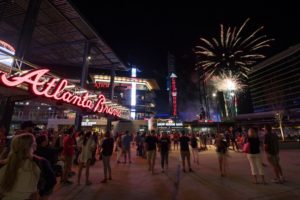
Atlanta Braves’ relocation from Atlanta to Cumberland brought an energy that lasts well into the night, as fans and patrons flock to local restaurants and neighboring attractions.
On November 11, 2013 Cumberland’s future forever changed as the Atlanta Braves announced they would relocate from downtown Atlanta to Cumberland. Many reasons went into this decision, including Cumberland’s easy access, mix of uses, and a welcoming county government; key ingredients in the secret sauce already known to many of us.
In what seemed like the blink of an eye, more than a billion dollars was channeled into a 2.5 million sf state-of-the-art stadium and mixed use development. In one fell swoop, one of the most visible and beloved brands in the country affirmed the investment decisions made by the CID years ago. And it wasn’t just the Braves.
Developers and capital markets investors swooped into the market after the announcement and growth went through the roof. In the five years between 2013 and 2018, the CID is tracking 10 million sf of new commercial and multifamily residential space, including seven Class-A office buildings, 2,000 hotel rooms, and 16,000 new residents. This equates to $3 billion in private investments.

Cumberland’s revitalization has attracted more Millennials to the community than any other submarket in metro Atlanta in recent years.
Properties are selling like hotcakes and–more importantly–at a premium, with buyers paying 250% more than the Tax Assessor’s listed values. This, of course, has demanded an influx of additional infrastructure necessary to accommodate this red-hot growth. To that end, almost $2 billion of public funding has helped rework roads, widen pedestrian plazas, build new pedestrian walkways, and a host of other needs. “Cranes and cones” is the mantra these days as it transforms this community for the better.
What was once an exclusively driveable suburban submarket is now an emerging community that not only includes corporate opportunity, but also dynamic residents, flourishing restaurateurs, lively sports fans, and energetic recreational seekers. I see young couples pushing strollers, walking dogs, or running along the trails.
Restaurants light up after offices empty out, and on game day…well, that’s the best time. Although many cried foul believing that the world would collapse from the weight of the epic traffic jams, there has been no discernible negative impact to the transportation network. Sure, there are cars that have to queue up to get on the adjacent highways, but most people come early and stay late. They now have that option after all.
As for the commercial properties owners and investors that make up the CID, their efforts are rewarded. More than $1.3 billion in real estate value was added over the past five years alone, proving that careful attention to investment (and reinvestment) strategies is money well spent.
How’s that for reengineering a road?
About the Author
 Malaika Rivers is the Executive Director of the Cumberland Community Improvement District (CID), a first-of-its-kind organization that innovated the model to fund critical infrastructure in Georgia’s commercial submarkets. For the past 24 years, Malaika’s engagements with commercial real estate investors, politicians, governments, and media have aligned interests, advanced infrastructure, and built thriving communities.
Malaika Rivers is the Executive Director of the Cumberland Community Improvement District (CID), a first-of-its-kind organization that innovated the model to fund critical infrastructure in Georgia’s commercial submarkets. For the past 24 years, Malaika’s engagements with commercial real estate investors, politicians, governments, and media have aligned interests, advanced infrastructure, and built thriving communities.
Her two-decade tenure with the CID has advanced an estimated $2 billion in constructed or in-process improvements leveraged from a business investment of $140 million. With 95 capital projects built or underway, Malaika and her team manage complex, multimillion dollar portfolios which have helped increase real estate value for commercial investors. Malaika’s contributions over the years have earned her prominent recognitions around the state, including “Notable Georgian” (2015, 2016, & 2017),” “25 Power Women to Watch,” and “Woman of Achievement.”


